List of Authors
>>About this blog
Recent blog post
|
[Dye]
August 31, 2017 09:00
It's September already...It's fast.
It has been three and a half years since he became a correspondent of the Chuo-ku Tourism Association. My son, who was a baby, is almost four years old.
The other day, I went to radio recording, one of the correspondent's activities.
In one corner of the program called "Hello! RADIO CITY" in Chuo FM, we will introduce the contents of the correspondent blog (`・ ・ ω ・ ́)!
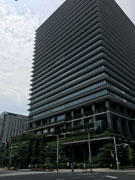 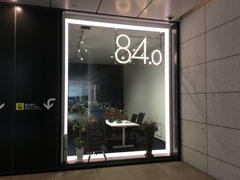
Central FM. The studio on the first basement floor of Kyobashi Square Garden.
You can see it from the outside.
It's actually the fifth recording.
When I was recording for the first time, I never thought I would be talking on the radio, so I was so thrilled in front of the microphone and I don't really remember what I said. (Is it now?...Laugh)
But every time, navigator JUMI leads me brightly, and I'm not good at speaking in public, talking about perapella, laughing, or speaking in public than I thought, but it's fun to talk here. 
However, the last sentence "I love, Chuo-ku!" For some reason, it gets shy and becomes a strange low tension (>_<)
I really love it! !Laugh
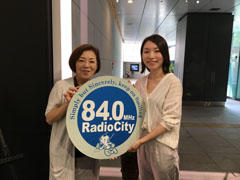
Navigator JUMI
As a working mom, she is a senior and a longing woman.
Also, there are not many opportunities for correspondents to meet each other, so it is one of the pleasures to be able to join together when recording. When you meet face-to-face and ask the story, "Oh, this person is a blog name XX!" 
This time, I was with "Sumida Fireworks".
The blog of "Sumida Fireworks" thought that the photos were particularly fashionable and cool.
I was happy to be able to take pictures and talk about cameras when writing blogs (*^^*)
In such a case, correspondents write blogs and talk on the radio about Chuo-ku.
Central FM "Hello! RADIO CITY"
There are new discoveries by listening to the backstory of the blog, etc., and it is recommended.☆
You can feel the charm of Chuo-ku more and more. of Chuo-ku more and more.
◆Central FM (84.0MHz)
HP: http://fm840.jp/
◆「Hello!RADIO CITY」: Monday to Friday from 12:00 to 13:00 (Re-18:00 to 19:00).
http://fm840.jp/blog/hello/
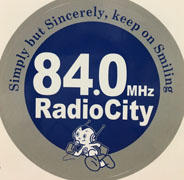
Valuable Information| Event Information| Gourmet Information| Shopping and shopping information| Ningyocho, Hamacho, Higashinihombashi area| Tsukuda, Tsukishima, Kachidoki and Harumi areas| Nihonbashi, Kyobashi and Yaesu areas| History, culture| Recommended Chuo-ku souvenirs recommended by correspondent| Correspondent's recommended information| Tsukiji, Shintomi, Minato area| Kayabacho, Hatchobori, and Shinkawa areas| Ginza area
Page top▲
[Shitamachi Tom]
August 30, 2017 14:00
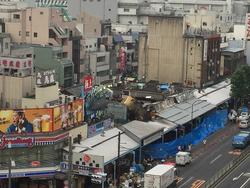
The fire that recently occurred in the [outside market] was a major incident in which the surrounding area was temporarily confused, but fortunately I was relieved without human damage. I was worried about what would happen because it was a dense area with old wooden buildings. You must have been surprised.
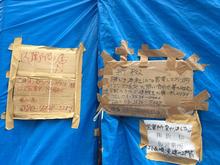
There were several shops that were unable to operate due to the collapse or damage of the shop due to the fire, and I was sorry, but there were a number of handwritten notes on the fire site, `` I am temporarily operating elsewhere '' I'm caught my eye. The sadness of the blue sheet is also encouraged by touching the strength that can never be seen.
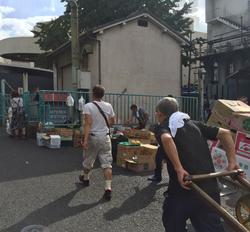 A greengrocer has been operating a blue sky only in the morning beside a nearby gas station. There are many regulars, and vegetables are sold one after another. Each time, encouragement and familiarity are exchanged, such as "Please do your best" or "I'm glad you got a business." A greengrocer has been operating a blue sky only in the morning beside a nearby gas station. There are many regulars, and vegetables are sold one after another. Each time, encouragement and familiarity are exchanged, such as "Please do your best" or "I'm glad you got a business."
Tsukiji is not only full of humanity, but also people with a strong heart that can withstand adversity support the food culture firmly. Please support the development and resurrection of Tsukiji [outside market]. And I hope you will come and visit us when you come near you. Thank you very much.
[Hikoharu Co., Ltd.]
August 30, 2017 09:00
I went to Ningyocho!
As you may know many people know, the history of the official place name "Ningyocho" is shallow. "Ningyo-cho currently has three chores, occupying both sides of the Toden line from the stop at Suitengu to Horidome-cho in the northwest direction, and the correct town names are Sumiyoshicho, Sakaimachi, Shinwa Izumicho, Yoshicho, former Osakacho, Kakigaracho and Matsushimacho. However, along with Suitengu, the name of Ningyocho was famous since Furusato," and "History of Chuo-ku".
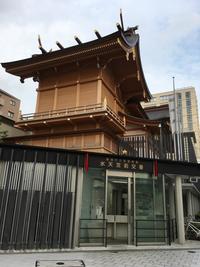
Suitengu Shrine from the Suitengu-mae intersection (it is said to be beneficial to safe delivery and water shortages, and it is crowded with many worshipers on the day of the dog)
One of the major factors in the development of Ningyo-cho was the relocation of Suitengu from Shiba-Akababashi Arima Kagami-yashiki to Arima Kagami-yashiki in Kakigara-cho in 1872. And it developed as the temple town of Suitengu.
"The monthly festival is held on the 1st, 5th, 15th, and the Dog Day every month, but on the Hatsusuitengu, Reitaisai festival (May 5th), and the Dog's Year Dog Day, many people come from a distance and visit the crowd. However, it is said that the prosperity is unprecedented. The entertainments of Kagura 75-za and local volunteers were dedicated, and fairs stood out inside and outside the precincts, and the prosperity that continued as a pilgrimage was a unique view of Tokyo."
However, after the Taisho Earthquake, emerging shopping streets were born in various places, and the development and the prosperity of department stores declined Ningyocho. Even after the war, shrines and temples was generally not shaken, so Sutengu did not receive the same attention as modern times.
By the way, Ningyocho transformed into a wonderful city in 2017 with the changing times.
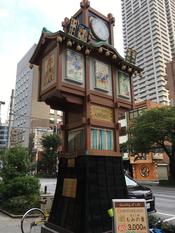 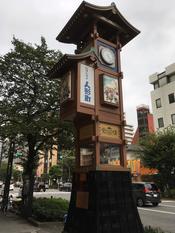
When you go up to the ground from exits A1 and A2 on the Hibiya Line, two Karakuri clocks will welcome visitors across Ningyocho Street.
Speaking of Ningyocho, amazake Yokocho, Kakigara Ginza Ruins, Saigo Takamori Yashiki Ruins, Junichirou Tanizaki Birthplace, Nihonbashi Seven Lucky Gods, Genji Store, etc. are famous. This time, I walked around the city with spots from the Suitengumae intersection to the amazake Yokocho intersection.
At the Suitengu intersection, the Mihara Domoto store and Shigemori Eishindo stand across Ningyocho-dori. Shigemori's Ningyo-yaki and Zeitaku Senbei are very famous as a souvenir of Ningyocho. The dorayaki and bean Daifuku of Mihara-do are also very popular, but I personally recommend salt rice crackers. Follow up with exquisite flavors. Follow Ningyocho Dori toward amazake Yokocho, and when the scent of nikki drifts from your right hand, you will arrive at Kotobuki-do. The golden potato with the scent of nikki is a specialty of Ningyocho. If you follow the road, you will find Gyokuido on your right. The Torayaki of Gyokudo is famous, but I would like to recommend "Tamabun". The bun is made up of 5 layers, and you can enjoy the appearance and the moderate sweetness is very good. It is also famous for its origins from amazake Yokocho that there was a sweet liquor store called "Owari-ya" in the current location of Gyoeido.
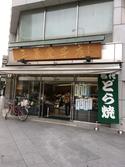 |
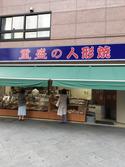 |
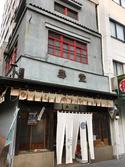 |
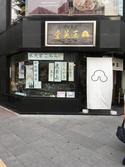 |
| Mihara Domoto Store |
Shigemori Eishindo |
Kotobuki-do |
Gyoeido |
Turn right at the amazake Yokocho. Go straight along amazake Yokocho leads to Meijiza. There are a number of long-established stores in amazake Yokocho, such as spelling shops and musical instrument shops dealing with shamisen and bechi. Then turn right at amazake Yokocho and go a little further.
There is also Yanagiya, which is famous for its sea bream. But this time, I decided to turn left without turning right.
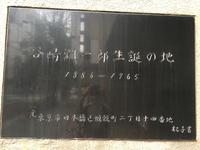 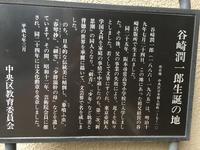
Immediately, the stone monument of "Junichirou Tanizaki's Birthplace" comes into your eyes. Junichirou Tanizaki was born in 1886 at his grandfather's house, Tanizaki Katsubunsho. It is said that the book on this monument is written by Mrs. Junichirou Tanizaki.
Beyond that is Nihonbashi Elementary School. It was currently undergoing renovation work. This is famous as the site of the Saigo Takamori mansion. In the Edo period, this area was the lower residence of the Sakai family of the Himeji clan. In addition, in the map of 1873, there is a description of "Kakigara-cho 1-chome Ichi-26333tsubo Kane, 586 yen Takamori Saigo".
Saigo Takamori will only stay here for two years from 1871 to 1873. He returned to Kagoshima in the political change in 1873, and caused suicide in the 1877 Southwest War.
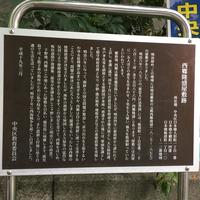 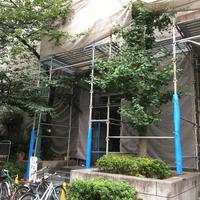
In addition, there is such an alley in Ningyocho, and you can feel the downtown atmosphere.
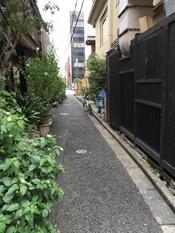 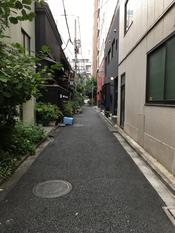 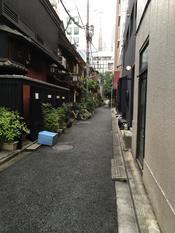
Finally, I would like to introduce two companies, Nihonbashi Seven Lucky Gods, and finish this blog.
 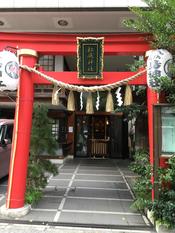
Chanogi Shrine Matsushima Shrine
Chanogi Shrine "In this area, there is the Nakayashiki of the Hotta family of the Sakura Domain in Shimousa, and the guardian angel worshiped enshrined deity. The tea tree planted around the shrine is said to be the origin of the name "From the Chuo-ku Monochiri Encyclopedia" (Hobukuro-son, Nihonbashi Seven Lucky Gods)
Matsushima Shrine "It is located in Matsushima-cho, and the date of first enshrinement is said to have been before Toru, and divine spirit is seeking Yoshimi Kanemi in 1585. Sumiyoshi, worshiping the god of food, when this area was a seashore, there was a pine tree Kojima in the sea. It is said that the shrine on the island was commonly referred to as Matsushima Inari. In 1713, when this area became a town area, Matsushima Shrine was famous for its annual Tori-no-ichi Fair, and it was incorporated into the first floor of the building. (the great power god of Nihonbashi Seven Lucky Gods)
This time, I wrote a blog focusing on a part of Ningyocho, but I haven't yet written about the charm of Ningyocho. I would like to describe the Kakigara Ginza ruins and Daimon-dori, which I could not touch this time, in another time.
Nevertheless, Ningyocho was a city with a very deep content in history and culture.
[Nyan,]
August 29, 2017 09:00
Many people may say that the Bon holiday is over and the summer vacation feeling is over.
Speaking of summer vacation, I go to work in Minato-ku, but looking around my seat, Aomori, Akita, Hiroshima, Ishikawa, Gifu, Nara, Niigata, Saitama ... Most of the members return home to their parents' homes. No, it's the level that if you're poor, people from Tokyo may be the least.
Naturally, the fact that people from all over the country gather in Tokyo has not started now, and writer Kafu Nagai wrote in "Boku Higashi Kitan" about restaurants in Ginza after the Great Kanto Earthquake (1923) "I'm entrusted to the management of people who came from Kansai or Kyushu every now," and the number of local people has decreased, and the number of local people has increased.
Isn't it one of the goodness and depth of Tokyo that absorbs the good points of the whole country and further develops the goodness to create a unique culture?
By the way, here, based on the "First Time Story Map" issued by the tourist association in Chuo-ku, "The Era where Kafu Nagai lived" (1879-1959) I would like to list the gourmet / food culture that was created.

・Fruit Parlor (1890)
・Oyakodon (1891)
・Pork cutlet (1899)
・Anmitsu (1930)
・Children's Lunch (1930)
・Leverfly (1932)
・Cutlet curry (1948)
・Hayashi Rice (1954), etc.
Looking back again, I felt that there were more things that were created in Chuo-ku during this era than I expected. It seems interesting to follow the story of Chuo-ku for the first time while filling the stomach.
[Shiba Inu]
August 23, 2017 14:00
The heat of Sanada Maru has not yet cooled down in the fall of 2017, but it was reported that the NHK New Year drama next year and 2018 was "Fuun Children" written by Koki Mitani! The era is the story of Ryotaku Maeno and Genpaku Sugita, who want to pursue Dutch studies (European culture), in the middle of the Edo period. Appeared by Ainosuke Kataoka (Ryotaku Maeno), Shinya Shinno (Genpaku Sugita), Koji Yamamoto (Gennai Hiraga), Masao Kusakari (Okitsugu Tanuma).
New Year's drama "Fun Children-Langaku Revolution (Reboryushi)"
If so...
The stage is, of course, in the middle of Edo, Tsukiji, Chuo-ku!
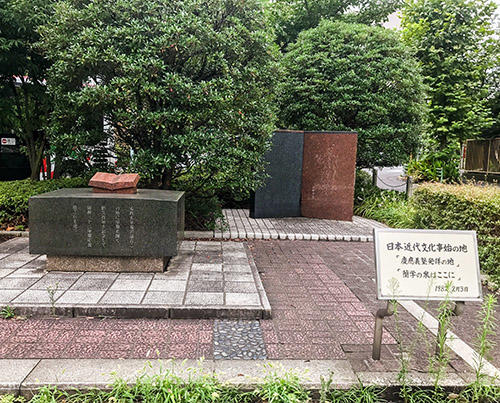
This is exactly the place where the Dutch studies of Sugita and Maeno were founded. A stone monument stands. Later, Yukichi Fukuzawa opened a Dutch school (later Keio University) in this place, so it stands alongside the monument of the birthplace of Keio University.
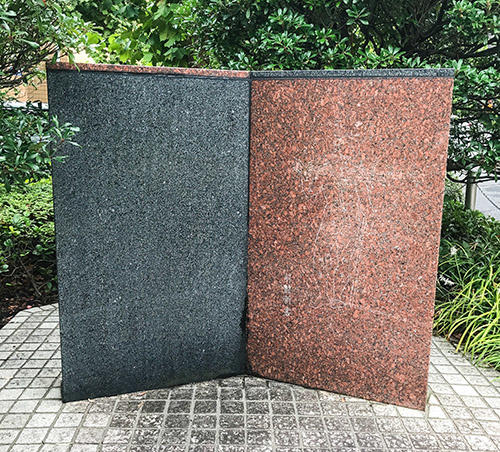
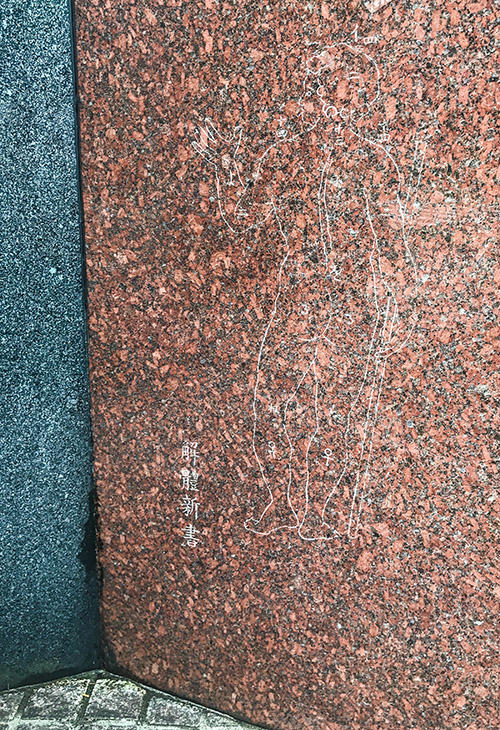
I think the image is hard to see, but it is a stone monument engraved with "Dismantling Shinsho".
This place was the Nakayashiki of the Okudaira family of the Nakatsu Domain (now Oita Prefecture). You can also check it on the old map. Ryotaku Maeno, a physician of the Nakatsu clan, will work with Genpaku Sugita and others to translate the Dutch medical book "Tarher Anatomia" at this location.
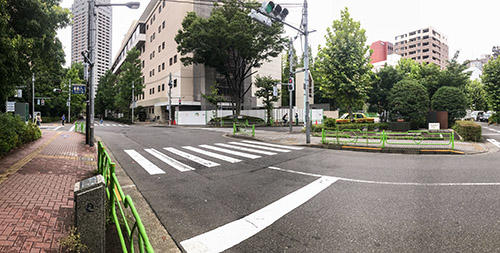
The stone monument is located at 11 Akashi-cho, Chuo-ku. It is a small square near the entrance of St. Luke Hospital. It's the right of the image. In the map below, it is a triangular plot around the bottom of the center.
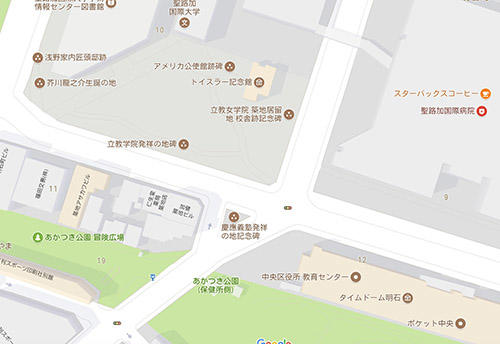
Here are the children of Dutch studies.
This place is Time Dome Akashi, which is known for its planetarium next to it, and Toysler Memorial Hall opposite to it.
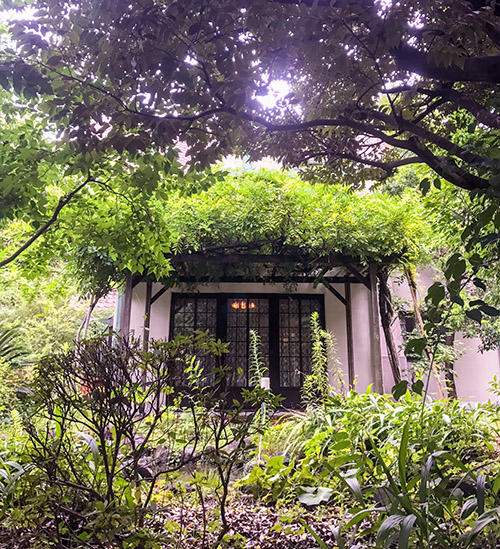
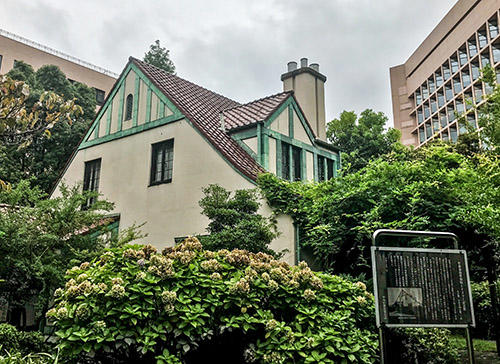
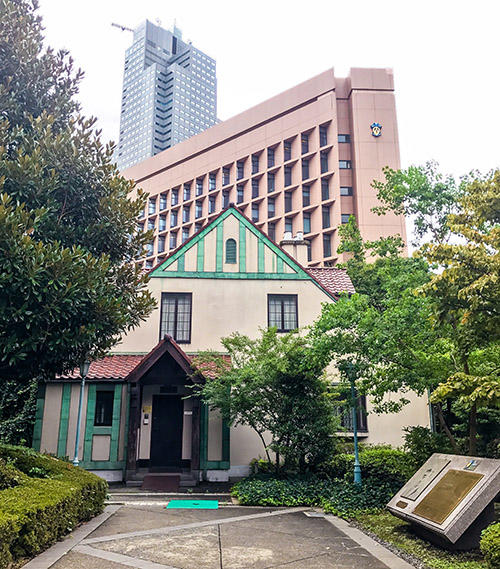
There are also Tsukiji Market, foreign settlements, late Tokugawa shogunate Historic Sites and Bungo Historic Sites, Showa Reconstruction Elementary School, and Tsukiji Honganji Temple. Even if you don't know the sightseeing spots, it's a fun place just to take a walk in Brabra. It is about a 15-20-minute walk to the center of Ginza.
By all means, please come and see the stage of Fengun Children!
By the way, I think Nagasakiya will probably appear in the drama....
Nagasakiya was a medicine wholesaler of the shogunate in Nihonbashi, and also served as a lodging house, so many of the directors of Dutch trading post and foreigners with specialized knowledge stayed there, and many scholars gathered to listen to their stories. Gennai Hiraga, Genpaku Sugita, Ryotaku Maeno, Junnan Nakagawa, Koyo Aoki, etc. were among them. Nagasakiya and the scholars are depicted by Katsushika Hokusai.
The location is 4-4-10 Nihonbashi Muromachi, Chuo-ku East Short Building, with an explanation board. It is very close to Choredo Muromachi and Mitsui Main Building. It is an important historical site that was the only window for Western civilization in Edo when isolation was severe.
Why don't you watch the drama stage from now on and enliven your feelings!
[Silver]
August 22, 2017 14:00
Speaking of Nihonbashi Honishi-cho, it was once famous as the location of Koza and now the Bank of Japan. Shirahata Inari Shrine is enshrined at 4-5-16 Nihonbashi Honishicho and attracts the reverence of local people.
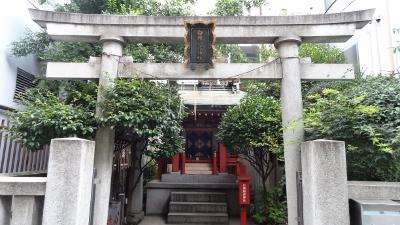
I went to visit a shrine on Friday in August. The precincts are carefully swepted, and we use water and two-tone beats.
Camellia around the approach to the shrine, and "Natsume", which blocks the harsh summer heat, gently greeted me.
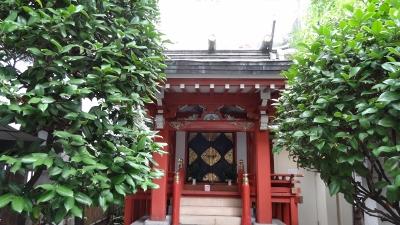
I felt very refreshed. I would like to express my deep respect to the people of the town council who are taking care of me. (It seems that you can visit only on fire and Friday. It seems to be locked at night. I think vermilion seal stamp's request is difficult.)
You can see the history from the roadside. Please see this history posted by the Shirahata Inari Shrine Reverence Society and Nihonbashi Honishimachi Town Association.
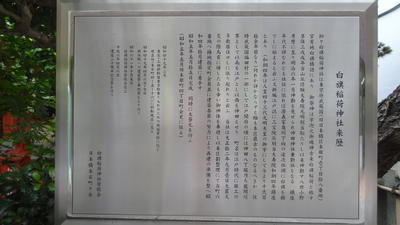 
I have copied your history for those who are interested. (Please note that some hiragana has been added and punctuation has been added.)
"History of Shirahata Inari Shrine
The suppression flag Inari Shrine is located on the government-owned land Shirahata Hashizume, Musashi-kuni, Tokyo (formerly 1-chome, Hongincho, Nihonbashi-ku), and enshrined deity is the god of Ukano. Since ancient times, it is called Shirahata Inari. Since the Kyoho Sanin Inu, Toyama School Shugen Daijuin Motoaki has been working separately, he has been a shrine. After arriving at Hidemaro Ono of the eighth generation, he was exempted from Shinto shrine in Meiji 6 and became Kanda Shrine Kaneshinsha. Although the age of the shrine is unknown, according to the company biography, it is said that Yoshiie Minamotono begins with a white flag on the head of the shrine as soon as Oshu descends. In addition, it says, "In the new edition of Edo magazine, Sanboin Temple School Betsudai Kotobuki-in 711 (711), enshrined in 711", and should it be the oldest in the main ward? In the past, it was part of Fukuda Village in Musashi Country, and at the time of the opening of Edo, Kanda Hatchobori Nochi Ryukangawakai was south of Edo and west of Kanda. The name of the town was derived from the residence of a large number of silver workers during the Edo period. We returned to Karasuari in the event of a major earthquake on September 1, 1923, but fortunately we evacuated the shrine, and since then we have designated a resettlement to the sixth place of our town by land readjustment, and we are preparing for reconstruction by the efforts of the members of the town council and the building committee. Start construction in January 1929. Completed on May 5, 1930. At the same time, a large festival was held (according to the history of the former Hongincho 4-chome Association in May 1930)
February 1974 Relocated to the current location (4-5-16 Honishimachi) in response to the acquisition of land for entering Tokyo Station on the Tohoku-Joetsu Shinkansen.
April 6 and 7, 1974 relocation ceremony celebrates the celebration of New shrine hall
Establishment of the Shirahata Inari Shrine Reverence Society at the end of October 1986
On April 6, 1994, the 20th anniversary celebration of the Transition
Shirahata Inari Shrine Reverence Party
Nihonbashi Honishimachi Town Association
|
Links
|


![]()

![]()
![]()
![]() of Chuo-ku more and more.
of Chuo-ku more and more.
































